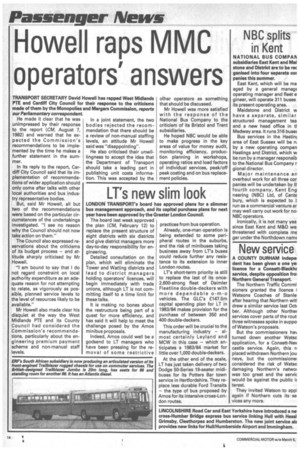LT's new slim look
Page 16

If you've noticed an error in this article please click here to report it so we can fix it.
LONDON TRANSPORT's board has approved plans for a slimmer bus management approach, and its capital purchase plans for next year have been approved by the Greater London Council.
The board last week approved• the plan (CM, February 12) to replace the present structure of eight districts with six districts and give district managers more day-to-day responsibility for engineering.
Detailed consultation on the plan, which will eliminate the Tower and Watling districts and lead to district managers holding operators' licences, will begin immediately with trade unions, although LT is not committing itself to a time limit for these talks.
It is making no bones about the restructure being part of a quest for more efficiency, and has said it will help to meet the challenge posed by the Amos minibus proposals.
Indeed, Amos could well be a godsend to LT managers who
have been pressing for the removal of some restrictive
practices from bus operation.
Already, one-man operation is being extended to some peripheral routes in the suburbs, and the risk of minibuses taking business away from LT's buses could reduce further any resistance to its extension to inner London routes.
LT's short-term priority is still to replace the last of its once2,600-strong fleet of Daimler Fleetline double-deckers with more dependable 0-m-a vehicles. The GLC's £147.5m capital spending plan for LT in 1983/84 makes provision for the purchase of between 350 and 400 double-deckers.
This order will be crucial to the manufacturing industry — almost certainly Leyland and MCW in this case — which anticipates a 1983/84 market for little over 1,000 double-deckers.
At the other end of the scale, LT has just taken delivery of two Dodge 50-Series 19-seater midibuses for its Potters Bar town service in Hertfordshire. They replace less durable Ford Transits — the type of bus proposed by Amos for its intensive cross-London routes.












































































































